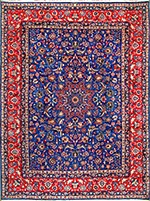Textiles Studies

Textile Research Works
Report - Bridges Coimbra 2011: Art Exhibition
Date of this Version
2011
Document Type
Article
Citation
Journal of Mathematics and the Arts (2011), Volume 6, 2012 - Issue 1, Pages 43-52.
doi: 10.1080/17513472.2011.628616
Abstract
An exhibition of mathematical art is held every year in association with the annual Bridges Conference exploring mathematical connections in art, music, and science. This year's conference and exhibition (http://gallery.bridgesmathart.org/exhibitions/2011-bridges-conference) took place in Portugal, July 27–31, at the University of Coimbra (founded in 1295). Participants from around the world gathered for an academic program of peer-reviewed papers and the juried art exhibition with mathematical content. The program was augmented by hands-on workshops, excursions to points of cultural interest and natural beauty, theatrical and musical events with mathematical themes, and a family day of programmes open to the public. While each of these offerings was ephemeral, the art exhibition catalogue [1] and the conference proceedings [4] are permanent publications designed to document current artistic and scientific research.
As an art historian, I was struck by the unique architectural and cultural context of Coimbra, a charming city and historical centre of learning, rich in artifacts and architecture that express interdisciplinary concerns analogous to those of Bridges participants. Situated in the upper town (‘Cidade alta’) atop a hill overlooking the Mondego River, the university landscape incorporates Renaissance monuments, a Baroque library, and physics and chemistry lecture halls of the nineteenth century. Just below the summit are the remains of the substructure of the Roman Forum with its network of intersecting barrel vaults (a tour of which was offered preceding the annual banquet) and a series of semi-circular arches on piers supporting a substantial aqueduct to bring water to the Roman city. At lower elevations are the Arab city gates with their typical arches that extend the arc of the circle beyond the horizontal diameter, and several magnificent Romanesque churches of the twelfth century, renovated and enlarged in the Gothic period (thirteenth century), again during the Renaissance and with additions of the eighteenth and nineteenth centuries. Unique to these churches are the early cultural influences of Portugal's vast overseas empire that resulted from the sixteenth century's Age of Exploration and Discovery – extending from Brazil in the Americas to Cape Verde off the coast of Africa, Goa on the Indian Ocean, and Macao on the China Sea.
Coimbra's cultural history embraced us, offering a frame through which to view the exhibition of contemporary mathematical art.


Comments
Links to publisher site; Taylor & Francis / Informa Ltd